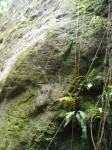 Locals Shirley Osborne and Vaughn Barzey were hiking on the Caribbean island of Montserrat this past January when they saw some carvings on a moss-covered rock face. They reported their discovery to the authorities. Volunteers with the Montserrat National Trust, archaeology professors and students from universities in the United States and elsewhere in the Caribbean studied the carvings in the hills near the town of Soldier Ghaut (Ghaut means “abrupt ravine” in Montserratian) about five miles north of the capital city of Plymouth. Officials kept the find under wraps until researchers confirmed that they were indeed ancient petroglyphs, the first ever discovered on Montserrat.
Locals Shirley Osborne and Vaughn Barzey were hiking on the Caribbean island of Montserrat this past January when they saw some carvings on a moss-covered rock face. They reported their discovery to the authorities. Volunteers with the Montserrat National Trust, archaeology professors and students from universities in the United States and elsewhere in the Caribbean studied the carvings in the hills near the town of Soldier Ghaut (Ghaut means “abrupt ravine” in Montserratian) about five miles north of the capital city of Plymouth. Officials kept the find under wraps until researchers confirmed that they were indeed ancient petroglyphs, the first ever discovered on Montserrat.
They are stylistically similar to petroglyphs made by the indigenous Amerindians (commonly referred to as the Arawaks, archaeologically known as the Saladoid culture) on Caribbean island like St. Kitts, St. Vincent and the Grenadines, among others.
“We have Amerindian artifacts on the island, but had not seen petroglyphs,” said Sarita Francis, director of the Montserrat National Trust. “These are the first, that we know of, that have been found here.”
Initial analysis suggests Montserrat’s petroglyphs are between 1,000 and 1,500 years old, Francis said, though carbon dating will paint a clearer picture of the images’ origins.
The petroglyphs consist of geometric shapes and what may be stylized animal or human figures. One figure could be a bat. Another with two deep circles cut from the stone and a line underneath is more than a little reminiscent of a rudimentary face design. The mouth doesn’t turn up at the corners, but it still manages to look like a smiley face.
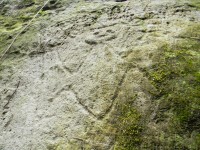
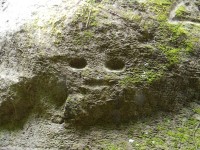
The earliest artifacts found on the island long predate the Arawaks. Flint blades, flakes and other evidence of knapping about 2,500 years old have been found in the central hills of Montserrat and judging from the style and technology of the lithic materials, archaeologists believe the first settlers came from South America between 4,000 and 2,500 years ago. This Archaic, pre-ceramic culture was displaced with the arrival of the Arawak between 500 and 300 B.C. who settled Montserrat until they in turn were displaced by the raiding Caribs (also known as the Kalinago). By the time the Spanish arrived, the Awarak had left the island and the Caribs do not appear to have settled it. The next wave of settlers came in 1642 and were predominantly Irish.
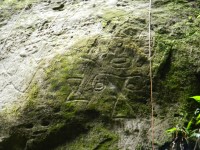
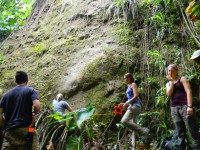
I love Petroglyphs and these look extremely interesting. I shall look forward to more news about these as to what they may be telling us. Great pics. Thanks Livias.
Kalinagoarawak ..kalinagoarawak …BAT – MAN !!!
They do not appear to be that old. There is no growth within the carvings themselves.
I agree with Russell. The ‘petroglyphs’ do not look worn or aged the other petroglyphs I have seen. I’ve done considerable research on the migration of boat people across the pacific, settling Central America and proceeding on to the various islands in the Atlantic. The culture is almost always referred to as the Arawak. This almost sounds like an attempt to displace the Arawak as the settlers of the various islands. The conquistadors did not settle anything. They invaded, murdered and pillaged. The same goes for any subsequent ‘settlers’ since there was already civilization and culture living on these islands. Like how Columbus didn’t discover anything. The hundreds of tribes or 10,000,000 people living in North America had been doing so for 15-20κ years. It was an invasion, not a discovery or settlers peacefully ‘settling’ in.
I’m not sure what part of this story suggests to you that the Arawak are being marginalized. The petroglyphs are being attributed to the Arawak, not to previous Amerindian cultures or later European settlers. I take your general point on the conquest of Central and South America, but it doesn’t quite apply in this case. Carib raids displaced the Arawak on Montserrat before the Conquista, but the Carib themselves never settled the island. Montserrat had no known residents for about 200 years before the European settlement.
First of all, cultures of the Western Hemisphere are not Amerindian, they are Indigenous, Native or Aboriginal peoples of the Western Hemisphere. When the Invasion, murder, torture and pillaging took place, it affected ALL tribes from Alaska, Canada, North, Central, South America, in addition to ALL of the islands on the Atlantic coastline, to the islands scattered across the Pacific. The conquistadors and catholic priests said the same thing about the Maya, they had disappeared before the conquistadors ‘discovered’ their cities and temples, yet still felt compelled to collect all sacred texts and set them afire in the courtyards of each city. The priests painstakingly drew their twisted perspective of how they saw things occurring and why. And amazingly there were Aztec, and Maya that were butchered just like the north and south american indigenous like the Inca, if they were not already stricken with the diseases the conquistadors brought with them.
Again, there is an obvious difference between these petroglyphs and say the pueblo petroglyphs, or the tree bark writings. It will be interesting how this pans out. It’s not as if archeologists have never been quick to the draw only to retract at a later point in time. Sounds like some top of the line forensics is in order.
Dear thehistoryblog.com,
I would like to give you a happy and excited 10 year anniversary greeting! You’ve really helped me achieve a few milestones in my own life and I started up a blog myself as a result! I run a blog talking about all manner of helpful household items ranging from hydroxychloroquine to ammonium nitrate to neuro-linguistic programming (NLP) :chicken:. It’s led me to be the top 6576th household blogger in the world!
You’ve been keeping up this excellent blog for 10 years and I really look forward to congratulating you on the 14 year anniversary in 2020 :yes: :boogie: :blush: